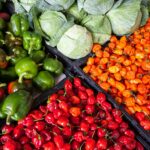Introduction to Seasonal Eating
Embracing seasonal eating is a mindful approach to nourishing our bodies and supporting local agriculture. By aligning our diets with the natural rhythms of the seasons, we can reap a plethora of health benefits while savoring the peak flavors and nutritional value of fresh produce. The concept of seasonal eating encourages us to enjoy a diverse array of fruits, vegetables, and herbs that are at their prime, enriching our meals with an abundance of vitamins, minerals, and antioxidants that promote overall well-being.
Incorporating seasonal foods into our daily menus not only boosts our health but also fosters a deeper connection to the environment and the agricultural cycle. This wholesome practice encourages us to appreciate the beauty of each season’s bounty, from vibrant spring greens to the rich hues of autumn squashes. By choosing locally grown, seasonal produce, we reduce the carbon footprint associated with food transportation and support sustainable farming practices that preserve the land for future generations.
Health Benefits of Seasonal Foods
Consuming foods that are in season not only benefits your health but also the environment. Seasonal foods are typically fresher, more nutritious, and often have a lower carbon footprint compared to out-of-season produce that may have been transported long distances. By choosing seasonal ingredients, you are supporting local farmers and reducing the energy required to grow and transport food, consequently decreasing the overall environmental impact of your diet. Furthermore, seasonal recipes are a great way to incorporate a variety of fruits and vegetables into your meals, providing a wider array of essential nutrients your body needs to thrive.
Incorporating seasonal foods into your diet is a simple yet effective way to enhance your well-being. Fresh fruits and vegetables that are in season are at their peak in terms of flavor and nutritional value, ensuring that you are receiving the maximum health benefits from your food choices. Whether you are enjoying a colorful salad made with crisp, seasonal greens or savoring a warm soup filled with root vegetables during the colder months, your body will thank you for nourishing it with the goodness of seasonal produce. Embracing the bounty of each season not only boosts your health but also adds a delightful variety to your meals, making your culinary experience more enjoyable and nutritious.
Environmental Impact
Shopping seasonally is an effective way to reduce the environmental impact of our food choices. By choosing fruits and vegetables that are in season locally, we can support sustainable farming practices and reduce the carbon footprint associated with importing out-of-season produce. This not only helps to lower the amount of transportation required for food distribution but also promotes the preservation of biodiversity in our ecosystems.
Preserving produce when it’s in season is another key aspect of minimizing environmental impact. By canning, freezing, or drying excess fruits and vegetables, we can avoid food waste and decrease our reliance on commercially processed foods that often come with excessive packaging. Additionally, preserving seasonal produce allows us to enjoy the flavors of ripe fruits and vegetables throughout the year, without having to resort to buying out-of-season items that are shipped from afar.
• Shopping seasonally supports sustainable farming practices
• Reduces carbon footprint associated with importing out-of-season produce
• Lowers transportation required for food distribution
• Promotes preservation of biodiversity in ecosystems
• Preserving seasonal produce minimizes environmental impact
• Avoids food waste by canning, freezing, or drying excess fruits and vegetables
• Decreases reliance on commercially processed foods with excessive packaging
• Allows enjoyment of ripe flavors throughout the year without buying out-of-season items
Seasonal Recipes
Seasonal foods offer a plethora of nutritional benefits that can be harnessed in delicious recipes. By incorporating fresh fruits and vegetables that are in season, you not only enhance the flavor profile of your dishes but also maximize their nutritional value. From vibrant summer salads bursting with seasonal greens and berries to hearty winter stews featuring root vegetables and squash, there is a diverse range of seasonal recipes to explore throughout the year.
Embracing seasonal foods in your cooking not only supports local farmers and reduces your carbon footprint but also ensures that you are consuming produce at its peak freshness. When planning your meals, consider the fruits and vegetables that are in season to create dishes that are not only flavorful but also packed with essential nutrients. By utilizing seasonal ingredients in your recipes, you can elevate your culinary creations while prioritizing health and sustainability.
How to Shop Seasonally
When it comes to adopting a seasonal eating approach, shopping smart is crucial. By prioritizing locally sourced produce that aligns with the current season, you not only promote eco-friendly eating practices but also support your community’s agricultural efforts. Success stories of individuals who have embraced seasonal shopping often highlight the freshness and quality of the ingredients they incorporate into their meals.
One effective strategy is to familiarize yourself with what fruits and vegetables are in season in your region. This knowledge will guide your shopping decisions, ensuring that you select the most nutrient-dense options available. By incorporating a variety of seasonal produce into your diet, you can enjoy a wide array of flavors and textures while maximizing the health benefits of your meals. Remember, a well-rounded shopping list that focuses on seasonal items can lead to creative, delicious, and nutritious meals that support your overall well-being.
Tips for Preserving Seasonal Produce
One effective method for extending the shelf life of seasonal produce is through proper canning techniques. By utilizing sterilized jars, fresh fruits and vegetables can be preserved for an extended period. This process involves packing the produce tightly into the jars, ensuring there are no air pockets, and then sealing them securely to prevent spoilage. Additionally, following reputable canning recipes and guidelines recommended by food safety organizations is essential to uphold the quality and safety of the preserved goods.
Another technique for preserving seasonal produce is dehydration. By removing moisture from fruits and vegetables, they can be stored for extended periods without the risk of deterioration. Dehydration can be achieved through various methods such as using a dehydrator, oven, or even the sun depending on the produce and available resources. Once properly dehydrated, seasonal foods can be stored in airtight containers in a cool, dry place to maintain their flavor and nutritional value.
Success Stories
As individuals embrace the practice of seasonal eating, they often experience remarkable transformations in their overall health and well-being. By incorporating an array of fresh, locally sourced produce into their diets, many have reported increased energy levels, improved digestion, and enhanced immune function. These anecdotal accounts are often supported by scientific research highlighting the nutritional benefits of consuming fruits and vegetables at their peak ripeness.
Furthermore, success stories in the realm of seasonal eating extend beyond individual health benefits. Many communities have witnessed a revitalization of their local food systems, with more consumers choosing to support nearby farmers and small-scale producers. This shift not only fosters a sense of connectedness to the land and its seasons but also contributes to the sustainability of local agriculture. In this way, the success stories of seasonal eating resonate not only on a personal level but also on a broader societal and environmental scale.



